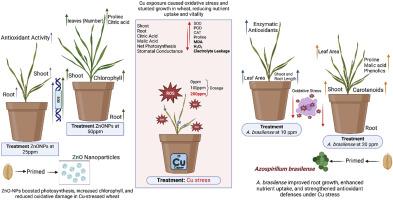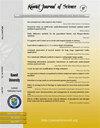氧化锌NPs和巴西氮螺旋菌对铜毒小麦生长和胁迫恢复能力的促进作用
IF 1.1
4区 综合性期刊
Q3 MULTIDISCIPLINARY SCIENCES
引用次数: 0
摘要
农业土壤中的铜(Cu)污染由于其在植物体内的积累而被认为是严重的健康风险,但利用纳米颗粒(NPs)和植物促生长根瘤菌(PGPR)对其影响和缓解策略的研究较少。考虑到氧化锌纳米颗粒(ZnO─NPs)和巴西氮螺旋菌(Azospirillum brasilense)在降低植物铜毒性方面的积极作用,进行了本研究。通过盆栽试验,研究了施用25和50 ppm氧化锌(NPs)和10和20 ppm巴西小麦(A. brasilense)对铜胁迫(0、100和200 mg kg - 1)下小麦(Triticum aestivum L.) Cu积累、形态生理和抗氧化防御特性的影响。本研究结果表明,土壤中Cu含量显著增加(P <;0.05)降低了植物的生长和生物量、光合色素、气体交换属性、糖以及植物根和芽的营养含量。相反,土壤中Cu含量显著增加(P <;0.05)增加了丙二醛、过氧化氢和电解质泄漏等氧化应激指标,并增加了柽柳根部有机酸的渗出模式。土壤中Cu浓度的增加增加了植物根、芽中酶促抗氧化剂活性及其基因表达的响应,增加了非酶促抗氧化剂的酚类、类黄酮、抗坏血酸和花青素含量。氧化锌─NPs和巴西木通过降低Cr毒性,提高了巴西木的生长和生物量,改善了光合机构、抗氧化酶和矿物质的吸收,减少了巴西木根系有机酸的分泌和氧化胁迫指标,从而减轻了铜胁迫对巴西木的负面影响。因此,研究结果表明,ZnO─NPs和A. brasilense的应用可以改善铜对T. aestivum的毒性,从而改善金属胁迫下植物的生长和组成,如有机酸的平衡渗出所示。本文章由计算机程序翻译,如有差异,请以英文原文为准。

Enhanced wheat growth and stress resilience under copper toxicity through ZnO─NPs and Azospirillum brasilense
Copper (Cu) pollution in agricultural soils is considered a serious health risk due to its accumulation in plants, but fewer studies have been conducted on its effects and alleviation strategies by using nanoparticles (NPs) and plant growth-promoting rhizobacteria (PGPR). Taking into consideration the positive effects of zinc oxide nanoparticles (ZnO─NPs) and Azospirillum brasilense in reducing Cu toxicity in plants, the present study was conducted. A pot experiment was conducted to determine the effects of the application of different levels of 25 and 50 ppm of ZnO─NPs and A. brasilense i.e., 10 and 20 ppm, on Cu accumulation, morpho-physiological and antioxidative defense attributes of wheat (Triticum aestivum L.) exposed to severe Cu stress (0, 100, and 200 mg kg−1). Results from the present study showed that the increasing levels of Cu in the soil significantly (P < 0.05) decreased plant growth and biomass, photosynthetic pigments, gas exchange attributes, sugars, and nutritional contents from the roots and shoots of the plants. In contrast, increasing levels of Cu in the soil significantly (P < 0.05) increased oxidative stress indicators in terms of malondialdehyde, hydrogen peroxide, and electrolyte leakage, and also increased organic acid exudation patterns in the roots of T. aestivum. Although the activities of enzymatic antioxidants and the response of their gene expressions in the roots and shoots of the plants and non-enzymatic ones, such as phenolic, flavonoid, ascorbic acid, and anthocyanin contents, were increased by increasing the Cu concentration in the soil. The negative impacts of Cu injury were reduced by the application of ZnO─NPs and A. brasilense, which increased plant growth and biomass, improved photosynthetic apparatus, antioxidant enzymes, and mineral uptake, as well as diminished the exudation of organic acids and oxidative stress indicators in roots of T. aestivum by decreasing Cr toxicity. Research findings, therefore, suggest that the application of ZnO─NPs and A. brasilense can ameliorate Cu toxicity in T. aestivum, resulting in improved plant growth and composition under metal stress, as depicted by balanced exudation of organic acids.
求助全文
通过发布文献求助,成功后即可免费获取论文全文。
去求助
来源期刊

Kuwait Journal of Science
MULTIDISCIPLINARY SCIENCES-
CiteScore
1.60
自引率
28.60%
发文量
132
期刊介绍:
Kuwait Journal of Science (KJS) is indexed and abstracted by major publishing houses such as Chemical Abstract, Science Citation Index, Current contents, Mathematics Abstract, Micribiological Abstracts etc. KJS publishes peer-review articles in various fields of Science including Mathematics, Computer Science, Physics, Statistics, Biology, Chemistry and Earth & Environmental Sciences. In addition, it also aims to bring the results of scientific research carried out under a variety of intellectual traditions and organizations to the attention of specialized scholarly readership. As such, the publisher expects the submission of original manuscripts which contain analysis and solutions about important theoretical, empirical and normative issues.
 求助内容:
求助内容: 应助结果提醒方式:
应助结果提醒方式:


